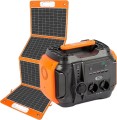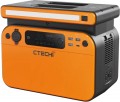In box
- Charging station. Portable charging stations are powerful “power banks” that can establish autonomous operation of an arsenal of home appliances, organize the supply of electricity in the country, during road trips or forays into nature, and charge many mobile phones overnight. Charging stations differ from traditional UPSs in their automatic operating modes. The power of such devices varies widely from approximately 100 to 3600 W. Mobile stations are charged from a regular household outlet, solar panels, car cigarette lighter socket, generator, or via a USB type C port with Power Delivery support. As for the configuration, the charging station can be supplied either by itself or
additionally with a solar panel,
battery pack,
inverter or
inverter and solar panel. In addition to the built-in battery of the charging station, you can also purchase
a battery pack separately.
— Battery pack. An additional battery pack to increase the total energy capacity of the charging station and, as a result, extend the period of autonomous power supply to consumers. Often, battery packs are produced for a specific model or family of charging stations in accordance with the dimensions of the device. Their design, as a rule, is stacked: a block with an additional battery is connected to the charging station f
...rom below or from the side.
— Charging station with battery pack. The standard configuration of such charging stations includes an additional battery pack, which allows you to increase the energy intensity of the device. Note that, if necessary, the additional battery can be easily detached from the charging station and it can be used without an external battery.
— Charging station with solar panel. Charging stations with a complete solar panel suggest the possibility of replenishing energy reserves in battery cells from the celestial body. Out of the box, they come with a folding solar panel that can be deployed on a sunny lawn and charge the device when there is no electricity in the outlet. Depending on the power of the charging station and solar panel, as well as weather conditions and daylight hours, the charging procedure can last from several hours to a full daylight hours (or even more).
- With an inverter. The delivery set of such charging stations includes an inverter, which is used to convert direct power energy from solar panels into alternating power for domestic needs. Note that in this case it is assumed that there is only one inverter - solar panels for charging a portable power station from the rays of the heavenly body will need to be purchased separately. Charging stations with an inverter and a solar panel are also available (see below).
— With inverter and solar panel. Advanced configuration, which implies the presence of a charging station, one or more solar panels and an inverter for converting energy from them. In this form, the portable power station impresses with its energy independence - it can be charged directly from the sun’s rays, even during a long absence of electricity in the outlets, and the charging station is ready for this right out of the box.Sockets (230 V)
Total number of outlets with output voltage. This is, in fact, the number of devices that can be simultaneously connected to the charging station without the use of splitters, extension cords and carriers. Accordingly, weaker charging stations have
one or
two sockets in their submission.
Powerful charging stations already have three or
more sockets “on board”.
USB A
Full-size USB A connectors are popular in computer technology, they are standardly used in adapter chargers for 230 V household networks and 12 V auto sockets. In charging stations, such outlets are widely used for charging gadgets.
- The total number of such ports can be very diverse (
1 USB,
2 connectors,
3 ports and even
4), since it allows you to connect for charging, and in some cases for power, various low-power devices -
smartphones,
tablets,
power banks,
lamps, etc. .
- The strength of the power. The maximum power output through the USB A connector to the device being charged. Note that different ports of the charging station can output different power (for example, 1.5 A and 2.1 A). In this case, the highest power strength is usually indicated.
— Power. The maximum
output power in watts (W) that the charging station is capable of delivering through the USB A connector to one charging device.
USB A (quick charge)
Full size
USB A ports with fast charging support. It allows you to charge your smartphone, tablet or other connected device much faster. The charging process takes place at increased power, and the current and voltage at each stage are regulated in such a way as to remain within the optimal values. However, it should be borne in mind that in our time there are many fast charging technologies and not all of them are compatible with each other.
- The strength of the current. The parameters of the current issued through the USB A fast charging connectors. Note that different voltage and current parameters can be output to different ports of the charging station. This item specifies the current values at a certain voltage (for example, 5 V / 3 A, 9 V / 2 A, 12 V / 1.5 A).
— Power. The maximum power in watts (W) that the charging station is capable of delivering through the USB A fast charging connector to one charging device. High output power allows you to speed up the charging process. However, the appropriate power must be supported by the device being charged - otherwise the speed of the process will be limited by the characteristics of the gadget.
USB type C
USB type C ports are smaller than classic USBs, and they also have a convenient reversible design that allows you to connect the plug in either direction.
USB type C was originally designed to be able to implement various advanced features: increased power supply, fast charging technologies, etc.
Since the port is relatively new and quite powerful (there are
USB type C with a power of 60 W and even
100 W), the total number of such connectors is often limited to
1 port, less often
two).
- The strength of the power. The maximum power output through the USB type C connector to a charging device. Note that different ports of the charging station can output different power (for example, 1.5 A and 2.1 A). In this case, the highest power strength is usually indicated.
— Power. The maximum power in watts (W) that the charging station is capable of delivering to one rechargeable gadget. The high output power of the USB type C port allows you to speed up the charging process. However, the appropriate power must be supported by the device being charged - otherwise the speed of the process will be limited by the characteristics of the gadget.
Wireless charger
In wireless charging mode, energy is transferred to the gadget being charged through an inductive surface, which is usually built into the upper plane of the charging station case. There can be one slot for
wireless charging or several of them are provided. The range of this technology does not exceed a few centimeters. However, this method of charging eliminates the fuss with wires and reduces wear on the connectors. One of the key disadvantages of this format is considered to be low power and, accordingly, slow charging speed.
DC output
The presence of a DC connector (or several such outputs) in the device to power external gadgets with direct current. The standard DC jack is round and has a pin in the center. However, its dimensions may differ in depth and diameter. The voltage output to the
DC output may be different. The most popular options are 18 - 20 V for powering laptops, 12 V for various specialized devices and automotive electrical accessories.
Via USB-C
The ability to replenish energy reserves in the battery cells of the charging station via
the USB type C connector. This port itself is small in size and has a convenient double-sided design, thanks to which the plug can be inserted in either direction. However, in charging stations it does not always work as an input interface.
DC input
DC connector for a distinctive round plug (like those used in many laptops) used to recharge the battery of the device. Note that
DC- in plugs may have different sizes, and chargers with such plugs may have different operating voltages. In practice, this leads to the fact that finding a suitable charger for a portable station is not easy, you need to be especially careful when searching.

